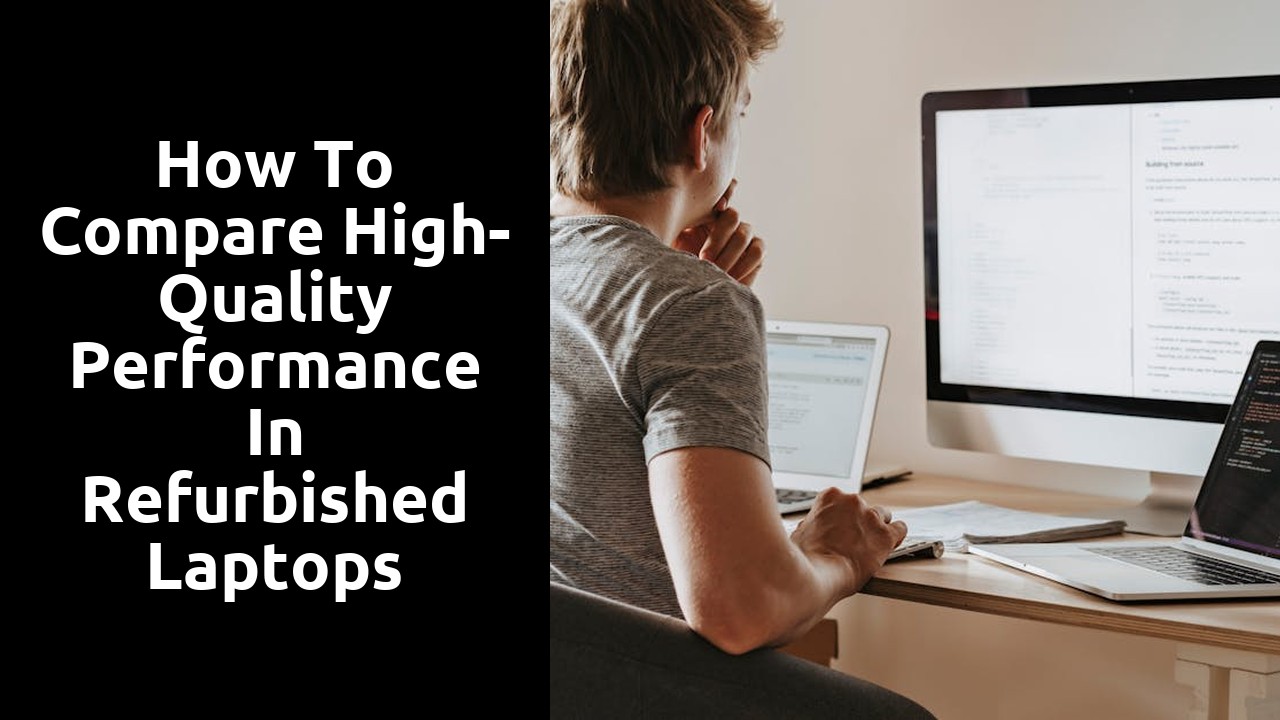
How to Compare High-Quality Performance in Refurbished Laptops
Verifying Screen Quality
When assessing the screen quality of a refurbished laptop, it is crucial to pay close attention to potential defects that may affect your user experience. Start by thoroughly examining the display for any dead pixels or screen damage. Dead pixels are pixel spots on the screen that do not illuminate properly, appearing either as black or a single colour. Even a few dead pixels can be distracting and reduce the overall visual appeal of the laptop. Likewise, screen damage such as cracks or scratches can hinder your viewing pleasure and may indicate rough handling of the device.
Next, scrutinise the screen for any signs of uneven brightness or colour balance. A high-quality refurbished laptop should display consistent brightness levels across the entire screen, without any areas appearing darker or lighter than the rest. Similarly, colours should appear vibrant and well-balanced, without any noticeable shifts or distortions. Keep in mind that an optimal screen quality contributes significantly to your overall computing experience, whether you are browsing the web, watching videos, or working on important projects.
Inspecting for dead pixels and screen damage
Inspecting for dead pixels and screen damage is a crucial step in assessing the quality of a refurbished laptop. Dead pixels, which are individual or small groups of pixels that do not function properly, can be an eyesore and affect the overall viewing experience. To check for dead pixels, carefully examine the screen under different lighting conditions and solid backgrounds. Look for any pixel that appears as a small black dot or remains a constant color when the rest of the screen changes.
In addition to dead pixels, it is essential to inspect the screen for any signs of physical damage. Scratches, cracks, or blemishes on the screen can not only be unsightly but also impact the functionality and longevity of the laptop. Take your time to thoroughly scan the screen surface for any imperfections and assess whether they are superficial or if they affect the display quality. By paying attention to these details, you can ensure that the refurbished laptop meets your performance and aesthetic standards.
Examining Keyboard and Trackpad
When it comes to assessing a refurbished laptop's quality, examining the keyboard and trackpad is essential. Firstly, check for any physical wear or damage on the keys and trackpad surface. Look out for fading letters on the keys or any signs of stickiness or unresponsiveness when typing or navigating using the trackpad.
Secondly, test the responsiveness of both the keyboard and trackpad by typing sentences and performing various gestures. Ensure that all keys register input correctly without sticking or feeling spongy. For the trackpad, verify that it accurately interprets gestures like scrolling, pinpointing, and multi-finger commands. By thoroughly evaluating the keyboard and trackpad, you can determine whether the refurbished laptop meets the performance standards you require for efficient daily use.
Testing responsiveness and wear
When evaluating the performance of a refurbished laptop, it is crucial to test the responsiveness of the keyboard and trackpad. Typing on the keyboard should feel smooth and effortless, with keys that register input accurately and consistently. Furthermore, pay attention to any signs of wear and tear such as faded letters on the keys, which could indicate heavy usage over time. Similarly, check the trackpad's sensitivity and responsiveness, ensuring that it navigates without any delays or erratic movements.
Aside from responsiveness, it is essential to examine the overall wear of the keyboard and trackpad. Look out for any loose keys or buttons that may affect functionality. Additionally, assess the general condition of the keyboard and trackpad for signs of damage or excessive wear, which could impact the usability and longevity of the device. By thoroughly testing the responsiveness and wear of these components, you can determine the quality and durability of the refurbished laptop.
Checking for Overheating Issues
It is crucial to thoroughly assess the potential overheating issues in refurbished laptops. Overheating can lead to performance degradation and even permanent damage to internal components. To accurately gauge the overheating risk, it is advisable to monitor the temperature of the laptop under heavy workload conditions.
One effective method to monitor overheating is by using diagnostic software to track the temperature of the CPU and GPU. These components are typically the main sources of heat generation within a laptop. By running demanding tasks such as video rendering or gaming, you can observe how the temperature levels fluctuate. Additionally, ensuring that the laptop's cooling system, including fans and vents, are clean and unobstructed is essential to maintaining optimal temperature regulation.
Monitoring temperature under load
When it comes to assessing the performance of a refurbished laptop, monitoring the temperature under load is a crucial step. Excessive heat can lead to reduced efficiency, system crashes, or even permanent damage to the components. Therefore, it is essential to ensure that the laptop operates within optimal temperature ranges during heavy usage.
One effective way to monitor the temperature under load is to use software tools that provide real-time data on the internal temperatures of the laptop components. By running performance-intensive tasks such as gaming or video editing, you can observe how the temperature fluctuates and ensure that it remains within safe limits. This proactive approach can help you identify any potential overheating issues early on and take necessary precautions to prevent any long-term damage to the refurbished laptop.
Related Links
Why High-Quality Performance Matters When Choosing a Refurbished LaptopHow to Choose a High-Quality Refurbished Laptop
How to Test the Performance of a Refurbished Laptop
What to Expect from a Refurbished Laptop in Terms of Performance
Why You Should Consider High-Quality Performance Refurbished Laptops